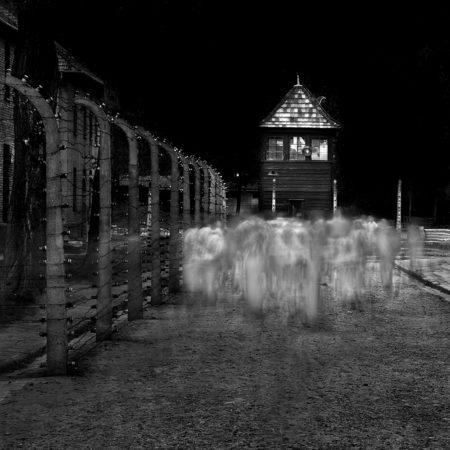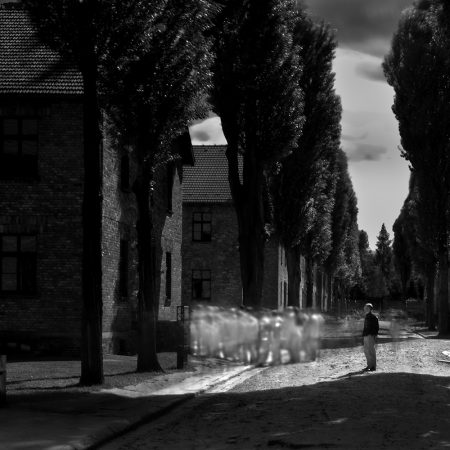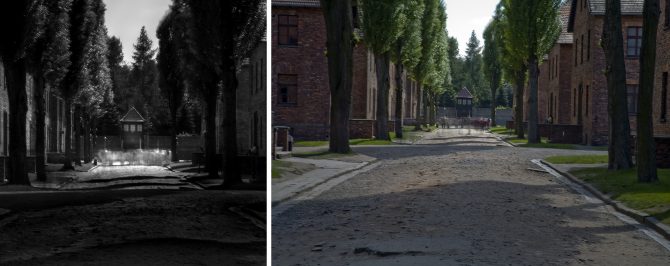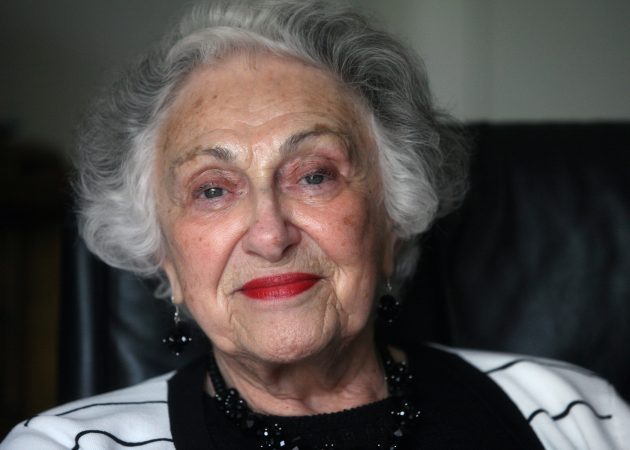April 6, 2012
The Story Behind “The Ghosts of Auschwitz-Birkenau”

I would like to tell the story behind “The Ghosts of Auschwitz-Birkenau.”
My wife and I were visiting my son who was serving in the Peace Corps in Ukraine (providing balance to his two brothers who were serving in the Marines). Being part Polish, we decided to visit our homeland and took a train to Krakow. Upon arriving discussions began on what to see and of course Auschwitz-Birkenau was high on the list, but secretly I hoped we wouldn’t visit the camps because I did not want see a place of such sadness. However my wife wanted to go and so I agreed.
We took a bus tour that would spend about 1 hour at Auschwitz and 30 minutes at Birkenau. Even though I had my camera equipment with me, I had not planned on photographing the camps because it seemed that this might be disrespectful. The tour began indoors and we saw the meticulous records the German’s kept of their victims and then the piles of personal effects: glasses, shoes, hair and other items.
This was just too overwhelming and I felt like I was suffocating, so I signaled my family that I was going outdoors. Breathing in the open air I began to feel a bit better and slowly walked, looking down at my feet. The thought then came to me: how many had walked here before me, in these exact same footsteps and now were dead? How many had taken this same path and then had been murdered?
I began to wonder if the spirits of those who were dead still lingered, did they still inhabit this place? And then it suddenly struck me that I must photograph the spirits of those who had died here. I instinctively knew how I would do that, I would use long exposures of the other visitors at the camps, who would stand in proxy for the dead. The enormity of this task hit me as I realized that the bus was leaving in 45 minutes and so I ran from location to location, working incredibly fast.
Each location had its own challenges, I had to photograph people without their knowing it, because if they thought I was photographing they would politely move out of my way. I developed techniques to fool people into thinking I was not photographing, I would set up my equipment and then talk on the phone or look in my camera bag, and then trigger the camera with a remote shutter release.
I found that the closer I was to the scene, the harder it was to get the shot because people would see me and move out of my way, not knowing that I actually needed them in the picture! Auschwitz No. 9 was the most difficult image to get, it took many exposures to capture these ghosts.

Another challenge was that people had to keep moving to produce the ghosting effects. So many shots were ruined when someone in the group would stop and interrupt the ghosting effect. In one image, Auschwitz No. 4, a man in the group stopped to read a historical placard. This is the only image that I’ve included a “mortal” because it seemed to say “I am completely unaware of the ghosts around me.”
It’s no simple matter to get the right ghosting effects; so many factors affect the image such as the color of the clothing people are wearing, the speed in which they walk, the angle they are walking in relation to the camera and of course the length of the exposure. I had to learn all of this in very short order and I was so grateful to be using digital so that I could get immediate feedback. There was so much to learn in such a short time, but I knew I had to finish before the bus left as I would not have another chance.
In one sense I felt prepared for this moment, for this opportunity. I had been working with long exposures for several years and I understood the basics, however I had never worked with people before and certainly not with unsuspecting subjects. I had to learn quickly and work quickly.
I do feel that I was inspired, both in concept and execution. As I looked at each scene I knew in my mind exactly how the finished image would look. However if you were to see the original shots and compare them to the final images, you would be surprised to see the extensive Photoshop work it took to bring the “shot” into compliance with my vision.

My processing included cropping the image to a square, darkening the scene for an almost nighttime look, increasing contrast, dodging up the ghosts and burning down distracting elements. You can see one “before and after” example above. Vision was the key to this series (remember my Rule of Thirds) and it was the constant that drove everything. You can view the entire Ghosts portfolio here.
Auschwitz-Birkenau is a depressing place, but I am glad that I went. I hope my images can portray the camps not just as a historical location, but as a place where real people lived and died.
Cole
P.S. I recently had the honor of meeting a group of Holocaust survivors who attended the opening of this exhibition in Dallas. I saw a very elderly woman in a wheel chair looking at my images and I introduced myself by saying: “Hi, my name is Cole Thompson and these are my images.” She responded by pointing at the wall and exclaiming: “These are my images!”

Her name was Edith Molnar and she had been interned at Auschwitz and recognized these locations. That was a humbling moment, to appreciate that you were talking to someone who had lived through these horrors, she was “living history.” Edith passed away several weeks later.
Cole

This is probably the best thing I will read today. I was moved to almost tears and at the same time my curiosity was piqued to learn the technical aspects of what you had created. Is there somewhere online this entire exhibit can be viewed? Just painfully hauntingly beautiful.
Cole, this project is one I’ve know about for awhile since you posted a few quite awhile ago. I’m pleased to see what you’re doing with them. The PS on your post is what is most poignant for me. “These are my images!” Amen to Edith for her comment rings of deep truth. As photographers we photograph from our life story. We bring to the act of image capture and image processing our paradigm and colored view. The same is true for the viewer of our work. So in the end the viewing of our images is NOT about us but about them. Its not about our vision anymore but is rather influenced by their paradigm. Great post Cole.
I was already familiar with this portfolio and had assumed you had a group of people doing what you instructed. The before and after example was most appreciated. It clearly demonstrates the large role vision and the post processing plays in a great photograph. Thank you once again for your interesting Blogs.
An amazing series, very powerful work. Bravo!
This is truly a great body of work, and I can think of no higher compliment than Edith’s statement. I once met a woman who was taken as a child by the Nazis to work in their labor camps. It is one thing to read about what happened, to try to take it in, it is something else to meet someone who lived it–who will speak about it. And in this case, these images speak volumes. They certainly show exactly what you intended, and so much more.
Cole, Have you read “Man’s Search For Meaning” by Victor Frankl? The author, a psychiatrist, spent 3 years imprisoned at Auschwitz, and wrote a classic about his experiences, and about the human spirit. There are now over 4 million copies in print.
I also had the honor of meeting two Auschwitz survivors a few years ago. I asked them if they would write something in my “Search For Meaning Book”.
This is what they wrote: “To Sam, from a survivor of Auschwitz at age 15. Never forget! Never! Ever!”
From the other: “Having experienced the worst of human behavior, and being the beneficiary of the heroism of individuals who saved my life, I believe in the indomitability of the human spirit.”
Your iconic series portrays visually what they were expressing. Your images, like their memories and admonitions, become a permanent part of this story. Great work.
I have read “Man’s Search For Meaning” by Victor Frankl and would like to relate another story. While visiting with the 10 survivors in Dallas, I was surprised at what I found. I did not see bitter or angry people, nor people who felt that they had been cheated, nor people looking for sympathy or revenge.
What I found were incredibly upbeat and happy people who were grateful for life. I was puzzled at first, but then remembered the lesson from Frankl’s book.
This type of person is the one who survive in such terrible circumstances; people who focus on what they have and look forward to seeing it again and not people who focus on what they have lost and how unfair life is.
It was a testament to me that Frankl was right.
Cole
Your masterful work on this subject should be “required reading”.
So many US citizens still say it can’t happen here.
Gerry, as I tell this story to high school school kids I am left with two impressions. The first is that they know a LOT about the Holocaust, it is well taught in the schools.
The second is that they believe that these kinds of things only happened in the “olden days” and that such things cannot happen in their modern world.
I do not fear dictators and tyrants as much as I fear the attitude that a Holocaust cannot happen again in our time.
Cole
It’s all been said here, except that this is quite possibly one of the most, if not the most compelling and obviously inspired series of images ever produced, falling upon the right person to create.
There are many incredible things about this series Cole. The one I feel is most incredible is how quickly you managed to figure out the perfect balance between speed of movement from your subjects and shutter speed. It’s very tricky and to come up with all of these fantastic images in 45 minutes is truly amazing. In addition, the technique you chose truly represents how you felt that day which is very powerful.
The first time I viewed these on your site, I was truly touched. I kept going back to them because I felt that your images were incredibly unique. I feel strongly by saying that this series should be part of a permanent exhibit in all holocaust museums.
Thank you all for your comments, personal experiences and insights.
Cole
I love this series. As I mentioned before the “The Ghosts of Auschwitz-Birkenau” was led me to follow you. I’m amazed at your proficiency to convert modern captures into images that take the viewer back in time. The fact that you shot everything in 45 minutes is remarkable. You not only have great technique but your vision excels. Keep up the great work, Cole.
i’ was a prisonnier jew a auschwitz-birkenau in 1944!!
i’ don’t think so if this pictures real’s ghost’s!!
its all a fake pictures!!
Cher Asher:
Je suis désolé si mes photos vous ont offensés, ce n’était certainement pas mon intention. S’il vous plaît comprendre que ce sont des œuvres d’art, et non des images réelles de fantômes. J’ai créé ces photos pour essayer de faire comprendre aux gens que des endroits comme Auschwitz-Birkenau ne sont pas des lieux historiques sans vie, mais des lieux où des personnes réelles ont vécus et sont morts.
Ces photographies ont été exposées au Centre Simon Wiesenthal a Los Angeles récemment, ils ont également été exposes dans autres musées Holocauste en Amérique.
J’espère que cela explique les choses et que vous comprenez Asher.
Merci.
Cole Thompson
Wow.. these photos are excellent! Great job! Being somewhat of a sensitive, I don’t think I could visit this place. All of the residual negative energy left behind by pain, despair, anger, and other such emotions would be too much for me! All of those poor people who died simply because of the evil of a monster!